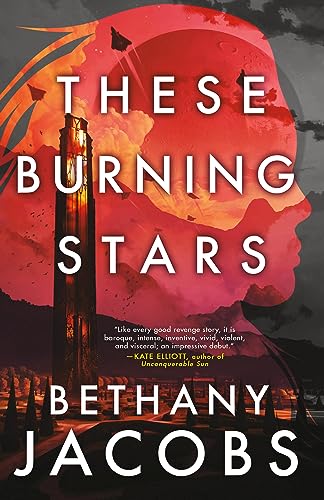Before getting into the gripping debut novel, These Burning Stars, by Bethany Jacobs, I need to mention a few things about this blog. After four years of writing reviews for SciFi Mind, I ran into a burnout period earlier this year and took some time off. I’m getting back into review mode again but find that another illness that has been bugging me for the last few years has created a new set of problems. It’s one of those things for which the treatment, at least early on, creates more debilitating side effects than the disease itself. So there’s a lot of down time, and that will make my reviews less frequent for the foreseeable future.
I’ve also been debating for some time if I should follow through with my original idea of using this blog to publish my own scifi stories. I’m leaning toward publishing them here in a separate section and then going the indie route to put out the completed book of connected stories. So I’ve been devoting more time, as it’s available, to writing fiction recently than reviews, and I expect that to continue. Bottom line is that I expect to review only those books that really move me deeply or teach me something I haven’t seen before rather than keep up, however poorly, with the constant flow of arcs from Net Galley and other sources. OK, enough of that and on to a book that has got me totally involved.
What drew me into These Burning Stars immediately were the sharply drawn characters and their epic struggles for revenge and vindication. In unforgettable portraits, we follow Esek Nightfoot and a character known as Six, both violent, determined and deviously clever at trying to destroy each other. Much of the narrative follows the perspective of Chono, a cleric of decidedly more reserved nature, though also a skillful fighter when she has to be. The story unfolds as planet-hopping battles of individuals caught up in webs of intrigue among powerful families.
The opening chapter fits the reader into the mind of Esek Nightfoot who is sadistic, manipulative, vengeful, beautiful and impulsively brutal. As a leading figure of a powerful family in the universe of the Kindom, an interplanetary dominion, Esek reviews the young recruits at a school for future elite members known as Hands of the Kindom. Hands are supposed to separate themselves from their aristocratic family politics and devote themselves solely to preserving order, but, of course, Esek breaks all the rules and is constantly scheming to build power so that she can one day become the head of the Nightfoot family. There are three groups of Hands: clerics (Esek is the youngest cleric in a century at twenty-two), cloaks, the thuggish police, and secretaries, who specialize in the law and the accumulation of power.
Esek reviews a line of six children, about ten or eleven years old, who are known only by numbers since they cannot claim an identity or gender until they have proven themselves. The master of the school sets the six battling each other with staves, and their fighting is brutal. Their discipline prevents them from making a sound no matter how much they might be hurt. Four and Six stand out, especially Six, as the fiercest and most dominating fighter of the group, and Esek is taken with “it.”
“Six children stood in a line, each as rigid as the staves they held at their sides. They couldn’t have been older than ten or eleven. They were dressed identically, in tunics and leggings, and their heads were shaved. They knew she was there, but they did not look up at her. Staring straight ahead, they put all their discipline on display, and she observed them like a butcher at a meat market. … And Six? The one who commanded this sudden tension, this careful advance? It stood a moment, taking them all in at once, stare like a razor’s edge. And then, it flew. She could think of no other word for it. It was like a whirling storm, and its stave was a lightning strike.”
These Burning Stars, Kindle edition, Locations 124 and 185
She makes an offer to the child which sounds like a curse. When older, it should approach her to be an initiate, a process that requires killing the cloaksaan who are her guards. Six must surprise her with something extraordinary, some feat of terrible violence and cleverness. And then, she says, even if successful, she may kill Six anyway. This sets out the deadly mutual fascination and obsession between the two that forms the driver of the story.
From this scene, the novel jumps ahead eleven years to the story’s present and the point of view of Chono, a respected cleric, once known as Four. There is altogether too much background information provided in her early conversations (my only gripe about the novel), but she is assigned the task of accompanying Esek, who is now second only to the aged Alisiana, head of the Nightfoot family, on one of her latest missions. The chapters then alternate as the events of the earlier timeline catch up to the present year of the story, and we slowly learn how the lives of Chono, Esek, Six and others are intertwined.
Esek’s mission is to secure a memory “coin” or holographic recording of one person’s memory of a critical event in Kindom history. A genius programmer or caster, known as Sidestep, is also seeking the coin that has come into the possession of a notorious pirate. We soon learn that the coin relates in some way to the story of the genocide of a people known as the Jeveni, whose home planet was destroyed and its surviving people turned into lowly workers and suspected terrorists during their long diaspora.
The major families of the Kindom have been fighting over control of the most important fuel source in this universe, a source the Jeveni had once controlled. Sidestep’s real name is Jun Ironway, a member of a Jeveni family she is determined to protect. While Esek and Chono pursue Jun in the present, Six and Esek follow their own game of hunter and hunted in the past, as Esek seeks a knock-out blow to destroy her nemesis. It’s a complex story of family intrigue, revenge and the quest for vindication of a long-oppressed people.
This is high adventure but also written with subtle observations of each character. I found it gripping all the way to its powerful ending. The tension around Esek and Six and their interactions with the other major characters are unforgettable.
My thanks to Orbit Books and NetGalley for an advance review copy of These Burning Stars on which I could base this review, reflecting solely my own opinions.




I hope you feel better soon. Thank you for writing “Sci-fi Mind”, it’s a pleasure to read it.
Best wishes
Thanks so much for your kind words. I’m doing well now, and that’s about as good as it gets. I’ll keep posting as long as I can.
All my best to you.